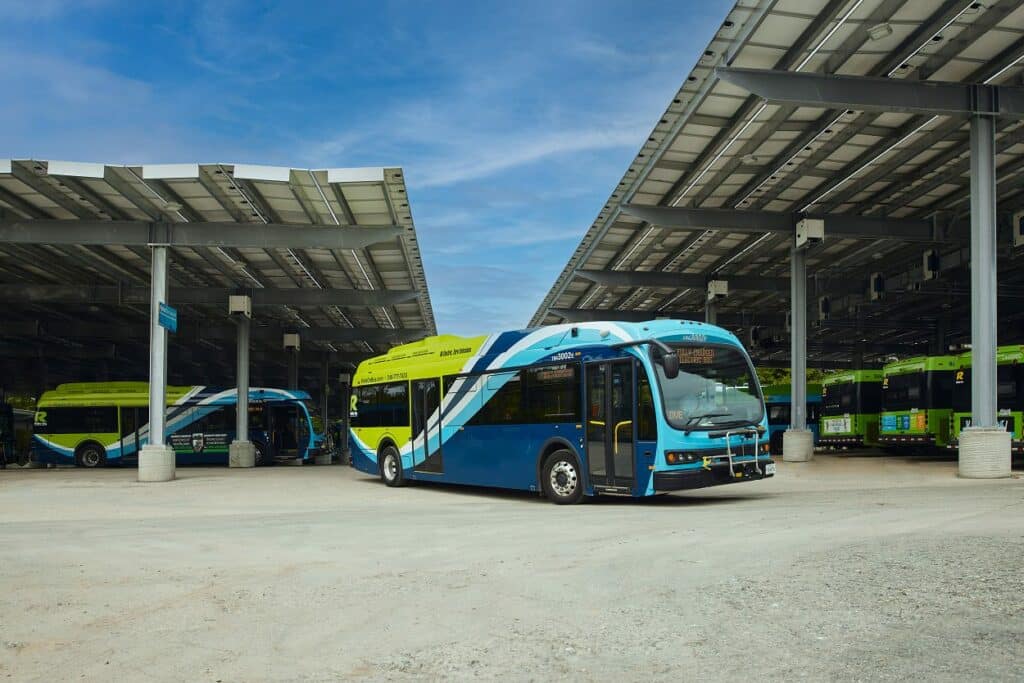Jana Gerber is President, Microgrid North America at Schneider Electric and is responsible for growing the commercial microgrid business and supporting customers in their sustainability and resilience journeys. In this role, she oversees go-to-market strategies and delivery for the North America region.
The EV Report recently had the opportunity to connect with Jana and learn more about bidirectional charging and the impact it will have on the industry.
What exactly does bidirectional charging mean?
Traditional charging is comprised of energy flowing in one direction. Bidirectional charging, on the other hand, can both charge and discharge energy into an external load. It can charge a vehicle electrically, and then use the vehicle battery to run a home or building, put power back on the grid, or even use the vehicle to run equipment. Often referred to as V2x, the bidirectional functionality also includes the ability to charge the vehicle during non-peak load times to avoid utility rate schedule penalties.
Is bidirectional charging a new phenomenon in the growth of the EV market?
Bidirectional charging has been considered for many years, and the market has accelerated over the past 12 months, especially with auto OEMs. The advancement of technology in this space has enabled charging to become more efficient and increased the potential for EVs to contribute to a shared electric grid. As communities, organizations, and cities evolve, we foresee bidirectional solutions being developed and introduced to the mass market.

How can bidirectional charging transform regular charging stations into vehicle-to-building (V2B) resilience hubs?
Utilizing V2B will be pivotal in ensuring added resilience for many facilities in the future. Microgrid software and solutions will help enable this function. With regularly charging stations, energy can only be directed one way. With bidirectional charging, it allows energy to be redirected and utilized for ‘emergency’ purposes. We call it an ‘energy insurance policy.’
Take school buses for example: each bus has about a 100kWH battery, 10X the load of an average home. They’re parked most of the time, with long dwell periods that could be aggregated and bid into a utility or ISO program. If 20 buses are placed in a depot, that would equal 2000kWH of storage – enough to run a sizable facility. If a bidirectional infrastructure were implemented, the buses could be mobilized for temporary power and would be tremendously useful in the event of an emergency.
To bring this to life, a startup in California that provides transportation for children and families in various school districts partnered last year with AutoGrid to use its fleet of buses to deliver power back to the electrical grid when needed most. Through the partnership, the fleet was provided with the necessary energy management and distribution software to transform them into one of the largest virtual power plants in the world.
What would the integration be like for this type of technology? How could companies or organizations leverage this energy source?
Bidirectional charging is the future of a decentralized energy infrastructure, transforming regular charging stations into vehicle-to-building (V2B) resilience hubs to power emergency shelters. If the right infrastructures are implemented, the technology should integrate seamlessly and intelligently to create a “safe haven” or backup power. This back-up source of electrical power could also help reduce – or even eliminate – carbon emissions. Schools, hospitals, shelters, stores, and companies across verticals would be able to leverage this charging technology to utilize cleaner, more resilient power.
What is the value of having bidirectional energy capabilities as a source of backup power? What industries or organizations would benefit from these energy sources?
Bidirectional energy unlocks resilience benefits of EV batteries, offers demand-response capabilities, and can decarbonize backup power. Using data and analytics, bidirectional energy solutions must harness both software as well as hardware to capitalize on its benefits. Among its many values, a fleet of electric vehicles can potentially have more storage capacity than an economically sized stationary battery energy storage system (BESS), and therefore extend the hours or days of island mode operation. These vehicles can be driven to charging stations where there is power, charged, and brought back to the site that is without power. Looking ahead, some utilities may even provide a monetary incentive to a site for demand management or load reduction capabilities of their zero-emission vehicle fleet. By being prepared to act as a mobile battery to charge/discharge as a demand response asset, the battery electric vehicles (BEVs) generate revenue which aids in justifying the capital costs of the BEVs and the associated support infrastructure.
Can this technology reduce carbon emissions? How so?
Yes, with this infrastructure in place, organizations and communities would not need to run nearly as many fossil fuel generators in back up power situations. If charging stations are primarily charging from solar PV, then the renewable energy content can be very high.
Can you provide an example of how Schneider Electric has successfully implemented bidirectional charging?
Schneider’s own microgrid team worked on a project that utilized bidirectional charging in Oakland, California. Through a partnership with Oakland Public Library, the project implemented bidirectional charging to turn the library into a V2B resilience hub. A new fleet of electric buses will one day store and discharge electricity to power filtered air conditioning and critical services at the West Oakland branch of the Oakland Public Library. Through Schneider’s microgrid control and switchgear technology, local residents will be able to use the library as a “safe haven” when it’s hot or wildfires are making the outdoor air unhealthy to breathe. What makes this project unique is the microgrid’s ability to use charged EVs or hydrogen-electric buses as energy and power resources. This project also demonstrates how various technologies can be integrated at-scale to create crucial backup power for the community and infrastructure more broadly.
Can this be delivered at scale?
In addition to the technology being delivered at-scale as described above, microgrids can be highly customizable while also introducing complexity into the power distribution equation, presenting time to market challenges. However, standardizing microgrid design and implementation processes can mitigate these challenges and accelerate much needed adoption. When designing microgrids from the start, the ability to add and subtract load will allow for additional fleets as needed.
Microgrids can also integrate with the larger grid, as well as other products, solutions, and hardware, all of which must be readily serviceable. Solutions that use artificial intelligence to automate system monitoring and maintenance, coupled with partner expertise, make it much easier to realize microgrid benefits.
If microgrid adoption is going to continue growing and achieve greener outcomes like bidirectional charging, the industry needs standardization of all aspects of the solution including the design, physical components, digital experiences, and data. In doing so, organizations can accelerate adoption and experience a faster return on their investment. A microgrid system ensures resiliency, stability, and scalability for bidirectional charging infrastructure.
What is the importance of having open, connected infrastructure compared to what we currently have?
There are so many advantages to having an open, connected infrastructure. Most notably, microgrid stability for power users and peak load sharing for the utilities and mobile energy storage systems in times of emergencies.
Two significant factors are at play here. First, the primary concerns of adding EVs to our current grid. They require a significant amount of energy from the grid to be able to charge, and the concern is that as electric vehicles become more popular, the grid could be more burdened than normal. Bidirectional charging has the potential to dramatically reduce that concern.
The second factor is grid stability as a whole. If bidirectional charging were mandated, or it was in use at a significant level, the grid having access to hundreds of thousands stored energy devices could actually help stabilize the grid.
How does bidirectional charging help accelerate a more digitalized and electrified world?
Digitization is the most important factor in the entire bidirectional discussion, as it is the key to the entire environment, charging times, rates of charge, utility coordination, and more. By having digital access to the status of your vehicle’s charge and discharge rate in bidirectional mode, consumers have the ability to make decisions regarding which loads can be managed to extend the rate of discharge or speed up the rate of charge, or charge at off peak times. The software and digital platform that allows for data gathering and digitization is what will enhance the next gen solutions for bidirectional needs and infrastructure standards.
To learn more about Schneider Electric, go here.








